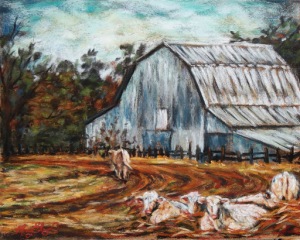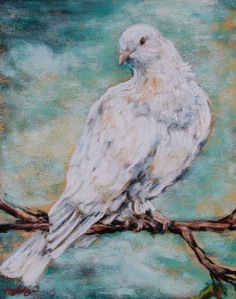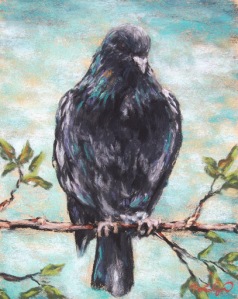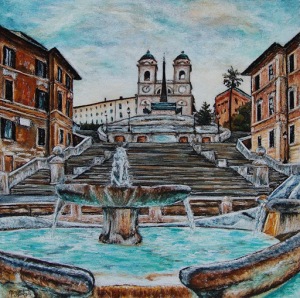
Gray Barn, 8×10 Soft Pastel on Card
I was drawn to this scene by the curved, rutted tracks in front of the tall gray barn. I loved the colors in the grass and dirt, and put in some simply drawn cows to keep the piece company.

Hay Fields, 12×16 Soft Pastel on Board
I love pastels, and I love teaching. Because of the nature of this dusty medium, it is hard to demonstrate to a large crowd since I cannot easily draw the picture upright, as on an easel, as the pastel dust cascades down the board with each stroke. To remedy this problem, in a recent pastel demonstration for the Birmingham Art Association, I inclined the board a bit to make it more visible and drew upside down, standing behind the table. My unorthodox method worked and here is the finished result: a colorful landscape that began upside down and was touched up a bit at home. I like the bright colors and think it is a pleasant, simple little scene.

Au Naturel, 5×7 Pastel on Board
My favorite first sign of Spring is when the Daffodils appear; we have some that pop up around a tree in the front yard. I especially love the simple, small yellow version…the kind without the frills and elaborate coloring. Just a little yellow flower, with its six delicate petals, its fragile trumpet, and its softly colored green stem. Simple, basic, au naturel.
In this small piece, I tried to work quickly, getting down the basic shapes and colors without overworking, to capture the warm simplicity of the image…two little flowers in an old honey jar. I used a board painted with pastel ground in varying textures.

Joy, 8×10 Soft Pastel
Woe, 8×10 Soft Pastel
Something I have found over the course of the past year is that Joy and Woe meet often in life, converging into one simultaneously unified and separately distinct emotion. I have written and created art on these thoughts before (“Sewing Lesson”), and the same poem by William Blake again inspires me. An excerpt from his “Auguries of Innocence”:
It is right it should be so
Man was made for Joy & Woe
And when this we rightly know
Thro the World we safely go
Joy & Woe are woven fine
A clothing for the soul divine
Under every grief & pine
Runs a joy with silken twine.
In these new pastels, which will be framed as a pair and form a separated but unified piece of art, I have personified Joy and Woe as birds; a pair that travels through our lives, touching down sometimes in turn, but often together. These emotions, as birds, sometimes land in our lives for a moment, and sometimes settle down to nest in our hearts for awhile. Joy & Woe are both part of this life, and to recognize it makes me more grateful for the Joy, and more patiently accepting of the Woe. These contrasting emotions come and go as birds to a branch, woven into the fabric of our lives as the limbs and leaves weave above our heads, and the roots below our feet.
After a few weeks, the Spanish Steps are finally complete!

Since the piece is so large and bulky (30×30″), I moved my workspace from my art desk to my kitchen table, propping it up on a makeshift platform of a pastel box and French box easel. I used the grid method to make sure I got this technical subject correct, checking angles and being careful to keep my lines straight. I use a grid, dividing the space into quarters first and then lightly into 16 spaces, only occasionally when enlarging to such a great extent. I sketch first with pencil, making only a few corrections by pressing with a kneaded eraser (never rubbing as it damages texture); I just draw over “mistakes” rather than spend time erasing, since the pastel will cover any marks-gone-awry. Over the correct pencil marks, I redraw with a charcoal pencil to give it more substance and to ensure no parts get “lost” in the vibrant pastel.

After the Spanish Steps were drawn and my area prepared, I began layering the pastel. Working on my self-prepared Pastel Ground surface proved different than I first expected. To the touch, the texture felt fine and grainy like a Pastelbord, but when I began applying the pastel for my sky, I found it more bumpy than sandy. At first I was frustrated working with such a rough texture that showed every pastel stroke. As I moved on to the rust-colored buildings, I embraced the difference of surface and adjusted my application to a more Impressionist-like, unfinished stroke, and with perseverance, am finally satisfied with the result.
I like the roughness I see when I look closely at the fountain, and it reminds me of some of Degas’ gritty looking pastel drawings. In the future, I will choose my surface based on the result I seek, adding Pastel Ground into the mix when I am looking for a deeper texture. This project was a learning experience and I am pleased to have been able to “experiment” a bit more than usual.

I am currently working on a commission for a large, off-size pastel of the Spanish Steps in Rome. Since my preferred surface is a sturdy, textured board, and Pastelbords don’t come in 30×30″, I have embarked on a new adventure: preparing my own textured pastel board. My first challenge was finding some sort of board in the size required. While in retrospect I probably could have bought and had cut a piece of Masonite board, I chose a 30×30 encaustic board in a frame, thanks to the help of my friends at Forstall Art Center.
The next step was to apply the texture with my jar of Golden’s Acrylic Ground for Pastels. I tested the ground on some smaller boards first, dividing the board into quarters and trying different methods of application: straight, smooth brushstrokes; crosshatched brushstrokes; random, mottled brushstrokes; smoothed with my fingers; and finally, gently sanded areas to soften the texture. Once dry, I tested the surface with several bright and contrasting pastels, looking for good coverage and hoping for uniform texture. Alas, the coverage was good, but all textures were lacking. After doing a bit of research, I settled into thinning the pastel ground with 20% water and applying the medium smoothly and uniformly with a foam roller that I bought for about $1. Perfection! It looks and feels so much like a Pastelbord, and I am very satisfied.
More on this project soon to follow…
Birds on a wire. When I was drawing this picture, this phrase echoed somewhere in my mind. I get a small sense of what it means, but like something free-floating; like a feather you can’t quite catch, just out of reach. To try and clarify this vague colloquialism, I googled the phrase and received similarly vague and mixed results. To some, “bird on a wire” gives a sense of freedom, a bird high in the air, able to fly and perch where it pleases. To others, it is an expression of limited freedom, as a bird tied to a wire, able to fly but confined. “Bird on a Wire” is the title for a song, a movie, and books. There were lots of “not sure what this means,” and “I think I heard it means this…”
When I hear the phrase, I think of spectators, onlookers, observing and judging from their perch, high above. I have been in that place, drawing conclusions with only a birds-eye view, missing the details-not in a place from which to judge. I have found that when looking at others, we should not presume to have full understanding. We can only see the surface, and maybe- maybe -a little bit more. The human life is so very complex; the human heart a mystery even to ourselves. As Henry James once wrote and William Boyd later borrowed, “Never say you know the last word about any human heart.”
When I drew these pigeons, I imagined, with a good bit of humor, their attitudes. The large one towards the right, with beak snubbed to the sky is the matronly ring leader, guiding her feathery followers with her too-lofty observations, when all they have is a birds-eye view. The pigeons are drawn with more simplicity than I usually employ, with fewer details and definition, lest we also think we understand the spectators too clearly.

I love creating art and I love teaching art. On Sunday, April 17, I will have the great privilege to demonstrate my techniques and methods for creating pastel paintings at the Hoover Library in Hoover, Alabama. It is a free event and will begin at 2:30 pm in “the Plaza.” I also have about 14 pieces on display for sale at the library. Stop by if you can!
There are so many “surfaces” upon which you can create your pastel drawings…papers of a spectrum of colors, smooth, rough or in between; Wallis paper, a card-stock thick paper with a sanded, toothy texture; Sennelier La Carte Pastel Card, a bit thicker with a sandy texture (my preference when creating small, off-size, or art that is to be matted); and Ampersand Pastelbord…my very favorite. Pastelbords are sturdy, like masonite, with a wonderful gritty texture that will hold layers and layers of pastel. Easy to frame with spacers in between the board and glass; easy to transport and never bending or curling. Although I stick to pure pastel painting, you can paint an acrylic wash on the board to tint the background, letting your color of choice show through. It lends itself well to thick pastel application and great coverage. You can put green over red and it doesn’t smear and blend unless you want it to! You can use the texture as a tool, dragging your pastel across and letting the toothy texture grab the pigment as it will. In my art classes, it is almost a joke that you can try all sorts of surfaces, but once you go “bord,” you never go back!